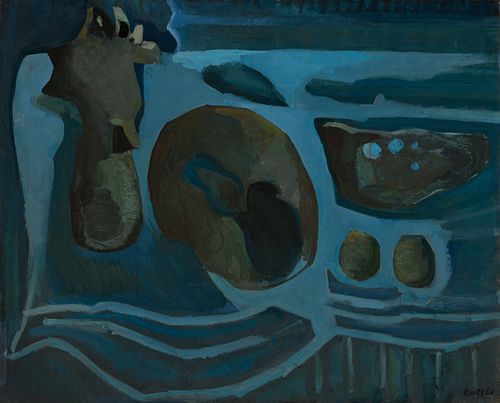FRANCISCO BORES LÓPEZ (Madrid, 1898- Paris, 1972). "Nature morte et bleu composition / composition en azul", 1960. Oil on canvas. Work reproduced in t
Lot 79
About Seller
Setdart Auction House
Carrer Aragó 346
Barcelona
Spain
Setdart Subastas was born in 2004 and is currently the first online art auction in Spain with solidity, prestige and reliability guaranteed by our more than 60,000 users. Setdart has a young, dynamic and enterprising team ready to successfully manage the purchase and sale of art works through custom...Read more
Estimate:
$45,000 - $50,000
Absentee vs Live bid
Two ways to bid:
- Leave a max absentee bid and the platform will bid on your behalf up to your maximum bid during the live auction.
- Bid live during the auction and your bids will be submitted real-time to the auctioneer.
Bid Increments
| Price | Bid Increment |
|---|---|
| $0 | $10 |
| $200 | $25 |
| $500 | $50 |
| $1,000 | $100 |
| $3,000 | $200 |
| $5,000 | $500 |
| $10,000 | $1,000 |
| $20,000 | $2,000 |
| $50,000 | $5,000 |
About Auction
By Setdart Auction House
Jun 17, 2021
Set Reminder
2021-06-17 06:15:00
2021-06-17 06:15:00
America/New_York
Bidsquare
Bidsquare : 19th & 20th Century Contemporary Art - Select Lots
https://www.bidsquare.com/auctions/setdart-auction-house/19th-20th-century-contemporary-art---select-lots-7081
Setdart Auction House sofia@setdart.com
Setdart Auction House sofia@setdart.com
- Lot Description
FRANCISCO BORES LÓPEZ (Madrid, 1898- Paris, 1972). "Nature morte et bleu composition / composition en azul", 1960. Oil on canvas. Work reproduced in the Reasoned Catalog, Volume II,1945-1972, p. 408. Provenance: Simon Collection (USA), purchased directly from the artist. Signed and dated in the lower right corner. Measures: 81 x 100 cm; 107 x 126 cm (frame). Lyricism and color are the undisputed protagonists of this piece, in which blue dominates the entire composition, creating the forms of this synthetic still life, through tonal gradations. The subtlety of the blues, added to the elements of fluid and clear geometries, show us the characteristic style of the painter's last stage, which was called "the white manner". The white manner includes works after 1955, which the artist himself contextualized as follows: "I continued to aspire to greater luminosity, disembodying the figures more and more at the same time. An attempt, in a certain way, to approach what the abstractionists aspired to by purely figurative means and, above all, to achieve something different from all those schools or movements, to achieve a special transparency. I wondered inwardly where such experiences would lead me... I think I know now: for the last two years I have returned to my first attempt at a plastic synthesis of the true. My painting, which was once dark, is today clear". A contemporary Spanish painter, belonging to the so-called New School of Paris, Francisco Bores trained at Cecilio Pla's painting academy, where he met Pancho Cossío, Manuel Ángeles Ortiz and Joaquín Peinado, among others. He also frequented the literary gatherings in Madrid related to ultraism. During this period he made engravings for a large number of magazines, such as "Horizonte" or "Revista de Occidente", and attended the Academia Libre de Julio Moisés, where he coincided with Dalí and Benjamín Palencia. In 1922 he participates for the first time in the National Exhibition of Fine Arts, and three years later he will show his work in the first Exhibition of the Society of Iberian Artists, but the lack of interest of the Madrid public for young art drives him to go to Paris. In the French capital he came into contact with Picasso and Juan Gris, and made his individual debut in 1927, contracted by the Percier Gallery. During these years, and through his friendship with Picasso, he begins his relationship with the art critic Tériade, who dedicates an extensive article to him in "Cahiers d'Art". It was at this moment that his artistic career began to take off. In 1929 he participates in the exhibition "Spanish painters and sculptors living in Paris", held at the Botanical Garden in Madrid. Also around this time he collaborated in avant-garde magazines such as "Litoral", "La Bête Noire", "Martín Fierro", etc. In 1931 he had a solo exhibition at the Georges Bernheim Gallery in Paris, and at the same time he signed a contract with the Swiss gallery owner Max Esiherberger. In 1932 and 1933 he exhibited at the Vavin-Raspail gallery in Paris, coinciding with the appearance of the first monograph on his painting. In the mid-thirties he is hired by the Zwemmer Gallery in London, where he holds a solo exhibition. His work is influenced by Picasso's cubism and, at times, by surrealism and abstraction. Francisco Bores became a master in the use of color, whose application sometimes follows abstract criteria, to such an extent that it replaces drawing or line when defining objects, figures and the space in which they are inserted. There is also a clear tendency in his language to experiment with color, which leads him to pamper the chromatic semitones. In the 1930s, Bores himself defined his painting as "lyricism and sensuality (...) within a composition organized in pursuit of a synthesis analogous to the impression produced by a single visual instant".
- Shipping Info
-
In-house shipping available. Please inquire at admin@setdart.com.
-
- Buyer's Premium



 EUR
EUR CAD
CAD AUD
AUD GBP
GBP MXN
MXN HKD
HKD CNY
CNY MYR
MYR SEK
SEK SGD
SGD CHF
CHF THB
THB
















